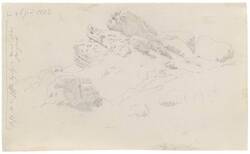The first room focuses on figures seen from the back, a compositional device undoubtedly playing a much larger role in Caspar David Friedrich’s art than any other painter’s.
Friedrich’s best-known work by far is The Wanderer above the Sea of Fog, which regularly appears in social media and the press to illustrate a vast range of topics – from the way Germany deals with its Nazi past to the climate crisis. This adaptability is primarily due to the painting’s composition: the world stretching away from the Wanderer is largely obscured by fog. What awaits him there? A happy future? A threat? We can’t tell. And more importantly – how does he feel? But since we can’t see his face, we do not know what he is thinking. Precisely because these questions remain unanswered, the painting – more than almost any other – is an ideal projection surface.
Friedrich painted all his pictures in his studio and the Wanderer is no exception. In these compositions, he closely followed sketches he had drawn directly from nature. Here, for instance, he initially sketched the rock in the foreground while hiking in Saxon Switzerland in south-east Germany. His sketch is on show to the left of the painting.
Admittedly, though, the exact landscape we and the Wanderer are looking at does not exist in nature. It is, in fact, an imaginary landscape. Friedrich assembled the view from individual elements which do exist, just not in this constellation. The striking rock formation to the right in the background and the table hill to the left are similarly found in Saxon Switzerland, but miles apart in different areas.
And just like his figures with their back to the viewer, such composed landscapes were typical of Friedrich’s works.
Further Media
- Location & Dating
- around 1817
- Material & Technique
- Oil on canvas
- Museum
- Hamburger Kunsthalle
- Inventory number
- Hamburger Kunsthalle, Inv.-Nr. HK-5161
